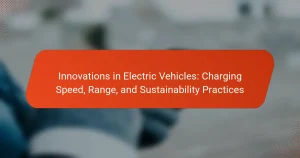Electric bicycles, commonly known as e-bikes, are bicycles integrated with an electric motor that assists the rider while pedaling. This technology enables easier navigation uphill or against wind resistance, with speeds reaching up to 28 mph based on specific models and local regulations. E-bikes typically feature multiple levels of pedal assistance, a battery range of 20 to 50 miles per charge, and require 4 to 6 hours for a full battery recharge. They contribute to eco-friendliness by minimizing fossil fuel dependency, promote physical activity, and help alleviate urban traffic congestion. Key considerations for e-bike users include battery life, charging time, weight, terrain suitability, maintenance needs, local regulations, and varying price ranges from $500 to $5,000.

What are Electric Bicycles and How Do They Work?
Electric bicycles, or e-bikes, are bicycles equipped with an electric motor that assists with pedaling. They typically have a battery that powers the motor, providing additional torque to the rider. This assistance makes it easier to ride uphill or against the wind. E-bikes can reach speeds of up to 28 mph depending on the model and local regulations.
The motor engages when the rider pedals or uses a throttle. Most e-bikes have multiple levels of assistance, allowing riders to choose how much help they want. The battery’s capacity often determines the range, with many e-bikes offering 20 to 50 miles on a single charge. Charging the battery usually takes 4 to 6 hours.
Electric bicycles promote eco-friendliness by reducing reliance on fossil fuels for transportation. They also encourage physical activity and can help reduce traffic congestion in urban areas.
What components make up an electric bicycle?
An electric bicycle consists of several key components. These include the electric motor, battery, controller, frame, wheels, and drivetrain. The electric motor provides propulsion, typically ranging from 250 to 750 watts. The battery stores energy, with common capacities between 300 to 700 watt-hours. The controller manages power delivery from the battery to the motor. The frame supports all components and is designed for stability and comfort. The wheels provide movement, usually equipped with tires suitable for various terrains. The drivetrain includes gears and chains, enabling efficient pedaling. Each of these components plays a crucial role in the overall functionality of the electric bicycle.
How does the battery impact the performance of an electric bicycle?
The battery significantly impacts the performance of an electric bicycle. It determines the range, speed, and overall efficiency of the bike. A higher capacity battery allows for longer rides without needing a recharge. For instance, a 500 Wh battery can provide a range of up to 50 miles, depending on terrain and rider weight. The battery also influences the maximum speed. Bikes with more powerful batteries can reach speeds of 28 mph or higher. Additionally, battery health affects acceleration and hill-climbing ability. A well-maintained battery ensures consistent performance over time, while a degraded battery can lead to reduced power output. Thus, the battery is crucial for optimizing an electric bicycle’s performance and user experience.
What role does the motor play in the operation of electric bicycles?
The motor in electric bicycles provides propulsion and assists in pedaling. It enhances the rider’s effort, making cycling easier, especially on inclines. Typically, these motors range from 250W to 750W, influencing speed and power. The motor engages when the rider pedals, allowing for a smoother ride. This assistance helps reduce fatigue on longer journeys. Electric bicycle motors can be hub-mounted or mid-drive, affecting weight distribution and handling. Research indicates that electric bicycles can increase average speeds by 15-20 mph. The motor’s efficiency contributes to longer ranges, often exceeding 50 miles on a single charge.
How do electric bicycles differ from traditional bicycles?
Electric bicycles differ from traditional bicycles primarily through the inclusion of an electric motor. This motor assists the rider in pedaling, making it easier to travel longer distances and tackle hills. Traditional bicycles rely solely on human power for propulsion. Electric bicycles typically feature a rechargeable battery that powers the motor. The battery capacity can vary, often ranging from 250 to 750 watts.
In terms of speed, electric bicycles can reach higher speeds with less effort. Many electric bicycles can assist speeds of up to 28 mph, compared to the average speed of 12-16 mph for traditional bicycles. Additionally, electric bicycles often come with various modes, allowing riders to choose the level of assistance they desire.
Electric bicycles also tend to weigh more due to the motor and battery, while traditional bicycles are generally lighter. This weight difference can affect handling and maneuverability. Lastly, electric bicycles may require maintenance specific to their electrical components, unlike traditional bicycles that mainly need mechanical upkeep.
What are the key features that distinguish electric bicycles?
Electric bicycles are distinguished by several key features. They typically include an electric motor that assists with pedaling. This motor can vary in power, commonly ranging from 250 to 750 watts. Electric bicycles also have a battery that powers the motor, with capacities usually between 300 Wh to 700 Wh. The range of electric bicycles can vary significantly, often allowing for distances of 20 to 100 miles on a single charge.
Additionally, electric bicycles come with various modes of assistance, such as throttle-only, pedal-assist, or a combination of both. They often feature lightweight frames and components to enhance efficiency. Many models also include regenerative braking systems that help recharge the battery during deceleration. These features collectively enhance the cycling experience, making electric bicycles a popular choice for commuters and recreational riders.
How does the riding experience vary between electric and traditional bicycles?
The riding experience differs significantly between electric and traditional bicycles. Electric bicycles provide motor assistance, making it easier to ride uphill or against the wind. This assistance can result in less physical exertion compared to traditional bicycles. Riders on electric bicycles can maintain higher speeds with less effort, often reaching speeds of 20 mph or more. Traditional bicycles require more pedaling effort, especially on inclines, leading to a more strenuous experience.
Electric bicycles often feature a smoother acceleration due to the motor’s assistance. This can enhance the overall riding experience, making it feel less taxing. Traditional bicycles offer a more direct connection to the cycling experience, with riders feeling every aspect of the terrain.
The weight of electric bicycles is typically higher due to the battery and motor, which can affect handling. Traditional bicycles are generally lighter, allowing for more agile maneuverability. Battery range on electric bicycles can vary, with many models offering 20 to 50 miles on a single charge. This allows for longer rides without physical fatigue.
In summary, electric bicycles offer easier riding with motor assistance, while traditional bicycles provide a more physically demanding experience.

What are the Key Benefits of Electric Bicycles?
Electric bicycles offer several key benefits. They provide an eco-friendly mode of transportation. Electric bikes produce zero emissions, reducing air pollution. They also promote physical activity, encouraging users to pedal more. The electric assist feature makes cycling accessible for all fitness levels. Riders can travel longer distances with less effort. Studies show that electric bike users cycle more frequently than traditional cyclists. Additionally, electric bicycles can save money on fuel and maintenance costs.
How does range affect the usability of electric bicycles?
Range directly impacts the usability of electric bicycles. A longer range allows users to travel greater distances without needing to recharge. This enhances the practicality of electric bicycles for commuting and recreational use. For instance, an electric bicycle with a range of 50 miles can accommodate most daily travel needs. In contrast, a bicycle with a 20-mile range may limit users to shorter trips. Studies show that electric bicycles with a range of 40 miles or more are preferred by users for their versatility. Users often consider range as a critical factor when selecting an electric bicycle. Therefore, range significantly influences the overall user experience and satisfaction.
What factors influence the range of an electric bicycle?
The range of an electric bicycle is influenced by several factors. Key factors include battery capacity, which directly determines how far the bike can travel on a single charge. The weight of the rider and the bike itself also affects range; heavier loads consume more energy. Terrain plays a significant role; riding uphill requires more power, reducing distance. Weather conditions, such as wind resistance and temperature, can impact battery efficiency. The level of pedal assistance selected by the rider influences energy consumption. Additionally, tire pressure and maintenance affect rolling resistance, which can alter range. Lastly, the efficiency of the motor contributes to how effectively energy is used during rides.
How can riders maximize the range of their electric bicycles?
Riders can maximize the range of their electric bicycles by optimizing battery usage and riding techniques. Maintaining a steady speed can help conserve energy. Using lower assist levels when possible extends battery life. Regularly checking tire pressure ensures optimal rolling resistance. Reducing weight by minimizing cargo can also enhance efficiency. Avoiding steep inclines and heavy acceleration conserves battery power. Planning routes with less elevation change helps maintain a consistent speed. According to a study by the University of California, Berkeley, proper maintenance and riding habits can increase range by up to 30%.
What speed capabilities do electric bicycles offer?
Electric bicycles typically offer speed capabilities ranging from 20 to 28 miles per hour (mph). This speed can vary based on the model and local regulations. Many electric bicycles are equipped with a pedal-assist feature. This feature allows riders to reach higher speeds with less effort. In the United States, the maximum speed limit for electric bicycles is often capped at 20 mph for Class 1 and Class 2 models. Class 3 electric bicycles can reach speeds up to 28 mph. The speed capabilities are influenced by factors such as motor power and battery capacity. Most electric bicycles use motors ranging from 250 to 750 watts. Higher wattage motors can achieve faster speeds more efficiently.
How does the motor power affect the speed of electric bicycles?
Motor power directly influences the speed of electric bicycles. Higher motor power, measured in watts, enables greater acceleration and higher top speeds. For instance, a 250-watt motor typically allows speeds up to 15.5 mph, while a 750-watt motor can reach speeds of 28 mph or more. This increase in speed is due to the motor’s ability to provide more torque, which is essential for overcoming resistance such as wind and incline. Additionally, motor power affects how quickly the bicycle can reach its maximum speed. More powerful motors reduce the time needed to accelerate. Therefore, the choice of motor power is crucial for riders seeking faster electric bicycles.
What are the legal speed limits for electric bicycles in different regions?
Legal speed limits for electric bicycles vary by region. In the United States, most states allow speeds up to 20 mph for Class 1 and Class 2 e-bikes. Class 3 e-bikes may have limits of 28 mph in some states. In the European Union, the limit is generally set at 15.5 mph (25 km/h) for e-bikes. Canada permits e-bikes to travel up to 20 mph (32 km/h) in many provinces. These regulations ensure safety and promote responsible use of electric bicycles.
Why are electric bicycles considered eco-friendly?
Electric bicycles are considered eco-friendly because they produce zero emissions during operation. Unlike traditional vehicles, e-bikes do not rely on fossil fuels. This significantly reduces air pollution in urban areas. Additionally, e-bikes consume less energy compared to cars. Studies show that e-bikes can reduce greenhouse gas emissions by up to 50% compared to cars for similar distances. They also promote sustainable transportation habits. By encouraging cycling, electric bicycles help decrease traffic congestion. Overall, e-bikes contribute positively to environmental sustainability.
What environmental benefits do electric bicycles provide?
Electric bicycles provide significant environmental benefits by reducing greenhouse gas emissions. They produce zero tailpipe emissions, which helps improve air quality in urban areas. According to a study by the European Cyclists’ Federation, e-bikes can reduce carbon emissions by up to 50% compared to cars for short trips. Additionally, electric bicycles consume less energy than motor vehicles. They promote sustainable transportation options, encouraging fewer car trips. This shift can lead to reduced traffic congestion and lower noise pollution. Overall, electric bicycles contribute positively to urban sustainability and environmental health.
How do electric bicycles compare to cars in terms of carbon footprint?
Electric bicycles have a significantly lower carbon footprint compared to cars. On average, electric bicycles emit about 22 grams of CO2 per kilometer. In contrast, conventional cars emit approximately 120 to 200 grams of CO2 per kilometer. This stark difference is primarily due to the energy efficiency of electric bicycles. They require less energy to operate and often rely on renewable energy sources for charging. Additionally, the manufacturing process of electric bicycles typically produces fewer emissions than that of cars. Therefore, choosing electric bicycles over cars can greatly reduce overall carbon emissions and contribute to a more sustainable environment.

What Are the Practical Considerations for Electric Bicycle Users?
Electric bicycle users should consider several practical factors. Battery life is crucial as it determines the distance an e-bike can travel. Most electric bicycles have a range of 20 to 50 miles on a single charge. Charging time also affects usability; it typically takes 4 to 6 hours to fully charge a battery. Weight is another consideration; electric bicycles can weigh between 40 to 70 pounds, impacting portability. Users should also evaluate the terrain they plan to ride on; some e-bikes are better suited for hills and rough paths. Maintenance is essential for longevity; regular checks on brakes, tires, and electrical components are necessary. Local laws regarding e-bike usage can vary; users must ensure compliance with regulations in their area. Finally, the cost of electric bicycles ranges widely, often between $500 to $5,000, depending on features and quality.
What are the maintenance needs of electric bicycles?
Electric bicycles require regular maintenance to ensure optimal performance. Key maintenance needs include battery care, tire pressure checks, and brake inspections. Batteries should be charged according to manufacturer guidelines to prolong lifespan. Tires must be inflated to the recommended pressure for safety and efficiency. Brake systems should be checked for wear and adjusted as necessary. Regular cleaning of the bike frame and drivetrain helps prevent rust and ensures smooth operation. Chain lubrication is essential to reduce friction and wear. Additionally, periodic professional inspections can identify potential issues early. These maintenance practices enhance safety and extend the lifespan of electric bicycles.
How often should the battery be serviced or replaced?
Batteries in electric bicycles should typically be serviced every 6 to 12 months. Regular servicing helps maintain performance and safety. Replacement is recommended every 2 to 5 years, depending on usage and battery type. Lithium-ion batteries, commonly used in e-bikes, generally last longer than lead-acid batteries. Monitoring battery performance can indicate when replacement is necessary. Signs include reduced range or charging issues. Following manufacturer guidelines ensures optimal battery lifespan and performance.
What maintenance tips can help prolong the life of an electric bicycle?
Regular maintenance is essential to prolong the life of an electric bicycle. Check the battery regularly for any signs of wear or damage. Clean the bike frequently to prevent dirt buildup, especially on the drivetrain. Inspect the brakes and tires for proper function and wear. Ensure that the electrical connections are secure and free from corrosion. Keep the chain lubricated to prevent rust and ensure smooth operation. Store the bicycle in a dry place to protect it from moisture. Follow the manufacturer’s guidelines for servicing the electric components. These practices can significantly enhance the lifespan of an electric bicycle.
What should potential buyers consider before purchasing an electric bicycle?
Potential buyers should consider several key factors before purchasing an electric bicycle. First, they need to evaluate the range, which is the distance the bike can travel on a single charge. Most electric bicycles offer a range between 20 to 100 miles, depending on the battery capacity and terrain. Next, buyers should assess the motor power, typically measured in watts. A motor with at least 250 watts is suitable for urban commuting.
Additionally, the weight of the bicycle is crucial. Lighter models are easier to handle and transport. Buyers should also consider the type of terrain they will ride on. Different electric bicycles are designed for road, mountain, or hybrid use. The battery charging time is another important aspect. Most batteries take 4 to 6 hours to fully charge.
Lastly, warranty and after-sales support are vital for long-term satisfaction. Many manufacturers offer warranties ranging from one to two years. These factors collectively ensure that buyers select an electric bicycle that meets their specific needs and preferences.
What are the key factors to evaluate when selecting an electric bicycle?
Key factors to evaluate when selecting an electric bicycle include battery capacity, motor power, weight, range, and features. Battery capacity, measured in watt-hours (Wh), determines how far the bicycle can travel on a single charge. Motor power, typically expressed in watts, affects the bike’s speed and ability to tackle inclines. The weight of the electric bicycle impacts its portability and ease of handling. Range refers to the maximum distance the bike can travel on a full battery, which can vary based on terrain and assistance levels. Additional features such as pedal assist modes, display options, and braking systems enhance the riding experience and safety. These factors collectively influence the overall performance and suitability of the electric bicycle for individual needs.
How can riders determine the right type of electric bicycle for their needs?
Riders can determine the right type of electric bicycle by assessing their specific needs. Key factors include the intended use, such as commuting, leisure, or off-road riding. Riders should consider the range they require, as different models offer varying battery capacities. Speed preferences also play a crucial role; some riders may prioritize higher speeds for quicker commutes. Additionally, riders should evaluate the terrain they will encounter, as this affects the type of motor and tire specifications needed. Weight capacity is another important attribute, especially for those carrying cargo or passengers. Finally, riders should test different models to find the best fit for comfort and handling.
Electric bicycles, or e-bikes, are bicycles equipped with electric motors that assist with pedaling, enhancing the riding experience by making it easier to travel longer distances and tackle challenging terrains. This article explores the various benefits of electric bicycles, focusing on their range, speed capabilities, and eco-friendliness. Key components such as the motor and battery are examined, highlighting their impact on performance, usability, and environmental sustainability. Additionally, practical considerations for potential buyers, including maintenance needs and selection criteria, are discussed to ensure informed decisions when choosing an electric bicycle.




